Mixed mimeographic and manuscript notebook of an officer attending the Naval Air Combat Information School (NACIS) at Quonset Point, Rhode Island in the summer of 1944. The material is bound in the original three-ringed notebook, all of which is in Very Good condition. The document runs 221pp, including 140pp printed documents (almost entirely mimeographed), 51pp of manuscript notes, and 30pp of mixed printed forms with manuscript additions). $1750.00
Most of the material is mimeographed from type originals, and most of that is marked "Restricted" or "Confidential" in the original sheets. This was the notebook of Joseph Coker, who did an excellent job of note-taking and was a superior observer, and who would continue his career post-war int eh field of defense analysis, and retire from government service as the director of the National Resource Evaluation Center in the Office of Civil and Defense Mobilization in the Executive Office of the President, which was really about preparing for nuclear attack and the world that would be left after that.
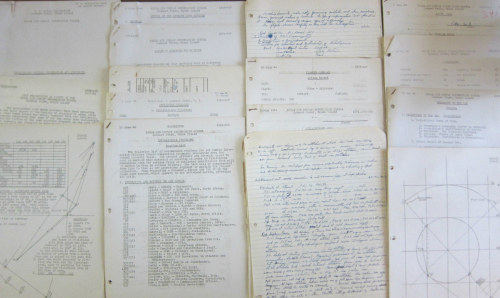 [Some of the notebook's contents--the foggy bit in the upper right corner is shadow, and not a stain.]
[Some of the notebook's contents--the foggy bit in the upper right corner is shadow, and not a stain.]
Contents, in order of appearance:
--USNAS, NACIS, “Preliminary General Information and Procedure”, Class No. 6-44, 8 June 1944-17 August 1944, for the 289 hours of classwork. Marked “to be destroyed when no longer needed” and “restricted”. 2 lvs, 8pp.
--General Notices (Daily schedule), 6pp.
--Outlines of the Student Duty Officer”. 4pp
--NACIS, “Japanese Aircraft Recognition” 25-11-43. 1 page. (See below for details.)
--Ship Recognition as Taught at the NACIS. 5-27-43. 3pp. “Restricted” A full and tight 3pp on the outline of a classification scheme.
--Course outline and schedule. 9pp of the daily regime at the school.
--“Procedure Syllabus”, 1 June 1944. 1pp
“Intelligence Procedure”, “Restricted”, 12 June 1944. 14pp. Includes reading list of interviews and report on air combat with about 120 named airmen; outlinnes for a course on air combat tactics, action reports, and battle notes, including amphibious warfare and ASW; airplane chracteristics; “interview and reports on air combt intelligence duties”; photographic interpretations; geographical references.
“Sample Pilot's Check Chart”, “Confidential” 1pp. Chart outlining altitude, RPM, max manifold pressure, mixture control,oil temp, oil pressure, cylinder head max, cowl flaps, fuel consumption, for 13 different operating conditions.
--MANUSCRIPT: 8pp general outline of intelligence procedures.
--“TBF's at Truk. Interrogatee: Pilot” 22 July 1944. Sample of a debrief after air combat over Truk Island. Second part: “F4U's at Saipan”. 2pp.
--“NACIS Index System”, “restricted”, 25 May 1944. 2pp
--EXAMINATION. “Procedure Test”, 30 June 1944, with printed questions and hand-written responses. 2pp
--EXAMINATION. “Antiaircraft Quiz”, 13 July 1944. 3pp, with printed questions and hand-written responses.
--“Fighter Command, Action report”, 20 July 1944. Sample form, not filled in. Also includes “Mission report (Navy) FORM MIKE” with general instructions. 13pp. Also includes “Life Raft and Emergency Performance Report”, 4/1/1944, 1 sheet. Also 1 short page of ms notes.
--“Geography of the War”, 20 March 1944. 8pp, plus 1 sheet of ms notes.
--EXAMINATION: “Tactics Quiz”, 8 July 1944. (Sample question:“Give a reason or reasons why it would be foolish to compare the original models of the P39 and the P47 on the same basis”.) 2pp
--MANUSCRIPT Notes: 16pp of tactics, mostly on torpedo tactics from planes, dive bombing, glider bombing (?). About 5000 words.
--MANUSCRIPT Notes, ASW, 8pp, about 3000 words, including a printed dagram/cutaway of a U-boat.
U.S. Depth Bombs (depth chargers), “Confidential”, 27 July 1944. 1 sheet. Table of the bomb type, weight of charge, total weight, nose, pistol, lethal radius, and impact-spacing (day and night).
--ASW Classification, “Confidential”, 4 May 1944, NACIS. Interesting 11-point grading system for assessment of attack on sub. 1 sheet.
--COMINCH Instructions for Briefing Squadrons on ASW Missions, “Confidential”, 29 July 1944. 1 sheet.
--EXAMINATION: ASW Quiz. 1 Aug 1944. 3pp
--Homework Assignments: 22 single-leaf assignments, all dated May 1944, and mostly concerned with navigation.
--Construction of Mercator Chart, Measurement of Course and Distance, determination of longitude and latitude. March 8, 1943. 13 leaves. Also: 6pp of manuscript notes.
--“Aerology”, by John Hamlin. Offset/mimeograph. 27pp.
--“Performance of Fighter Command Aircraft”, 26 January 1944. Lists engine, operational ceiling, climb rates, speed, and guns in charts for 34 aircraft. Marked “Restricted”. 3pp. Wonderful data. Accompanied by 12pp of manuscript notes outlining command structure of the Japanese, Russian, German, Italian, and British air forces. (See below for a images.) The air forces outlined in diagrams in the notebook include the U.S. Army Air Force, the Luftwaffe, the air forces of the Soviet Union, and the air force of the Imperial Army of Japan. I'm not saying that these notes are significant, just that they are from an unusual source, and so from that perspective alone they are interesting--that and the fact that the person who made the notes and took the classes became the head of the chief nuclear weapons preparedness organizations in the U.S.
--“Performances of German Aircraft” “Restricted”. 16 February 1944. 9pp
--“Instructions for Preparing Revised Form ACA-1 for reporting Aircraft action”, prepared by the Air Intelligence Group, Division of Naval Intelligence, June 1944. This is the only mass printed document of the lot. It is 11pp, and marked “restricted”. The document is accompanied by a printed form for the Aircraft Action Report (4pp)
SOME DETAILS:
Even from a relatively benign-sounding document in this collection there is considerable richness. For example, the document "NACIS, Japanese Aircraft Recognition, 25-11-43. 1 page." contains a lot of information. It is an extract “from Pilot's letter” describing the Japanese aircraft encountered and using the McCoy/Williams/Grattan shorthand-slang method for identifying the aircraft. Evidently using the Japanese names and designators was clumsy and complicated, so an alternative means was developed using common given names, trees, and birds to identify Japanese aircraft “In mid-1942, Captain Frank T. McCoy, a United States Army Air Forces military intelligence officer from the 38th Bombardment Group assigned to the Allied Technical Air Intelligence Unit in Australia, set out to devise a simpler method for identifying Japanese aircraft. Together with Technical Sergeant Francis M. Williams and Corporal Joseph Grattan, McCoy
- divided the Japanese aircraft into two categories; fighters and everything else...
- boys' names to the fighters,
- names of girls to the others...
- training aircraft were named after trees.
- single engine reconnaissance aircraft were given men's names...
- multi-engine aircraft of the same type were given women's names.
- (t)ransports were given girls' names that all began with the letter "T"
- Gliders were given the names of birds.”--edited, from Wiki https://en.wikipedia.org/wiki/World_War_II_Allied_names_for_Japanese_aircraft
Here are the “translations” of the U.S. Names for Japanese aircraft in this short report in order of appearance in the above-mentioned document:
- ZEKE: Mitsubishi A6M, Navy Type 0 Carrier Fighter. [This is the legendary “Zero” aircraft, so called as it was manufactured in the Imperial Year of 2600, or 1940, and adopting the final zero (or two) as a nickname in its Japanese designation. The “Zero” was “Zeke” for another six months or so before it was widely switched out. By the time of this report—November 1943—the “Zero”, which was recognized as the finest and most lethal carrier-launched fighter plane in then world, was decidely less so than, the Allies catching up by mid-1942 to make it roughly the equal of the best Alied fighter planes, and then increasingly less so until in 1944 it was considered outdated.
- HAP: Mitsubihi AGM3, Navy Type 0 Carrier Fighter Model 32
- OSCAR: Nakajima Ki-43, Army Type 1 Fighter
- TONY: Kawasaki Ki-61, Army Type 3 Fighter
RUFE: Nakajima A6M2-N, Navy Type 2 Interceptor/Fighter-Bomber - PETE: Mitsubishi F1M, Navy Type 0 Observation Seaplane
- DAVE: Aichi D3A
- VAL: Aichi D3A, Navy Type 99 Dive Bomber
DINAH: Mitsubishi Ki-46, Army Type 100 Command Reconnaissance Aircraft - LILY: Kawasaki Ki-48, Army Type 99 Twin-engined Light Bomber
- SALLY: Mitsubishi Ki-21Army Type 99 Dive Bomber
- NELL: Mitsubishi 3GM, Navy Type 96 Attack Bomber
- HELEN: Nakajima Ki-49, Army Type 100 Heavy Bomber
- BETTY: Mitsubishi G4M, Navy Type 1 Land-based Attack Aircraft
- TESS: Douglas DC2, Navy Transport
- EMILY: Kawanishi H8K, Navy Type 2 Large Flying Boat
MANUSCRIPTS:
here are some of the pages outlining the command structure of the major air forces of WWII.
R.A.F. (1944):
Japanese Air Force, February 1944:
Air Force of the Soviet Union (1944):
U.S. Army Air Force (1944):
German Air Force (1944):
The document below addresses an odd internal issue of mine, something that I've sort of followed around in some fashion in reading about WWII in the air, and especially in the Pacific, and especially for the precautions and supplies aboard USAAF aircraft in the event of a ditching. I knew from incidental and second-hand reading exposure that these supplies changed quite a bit from 1942 to 1943, but I had no idea that there was such a debriefing schedule established for life raft usage.
I would really be interested in the answers to #17. No doubt there is a collection of those answers, but I think I'll just have to leave those to mystery.

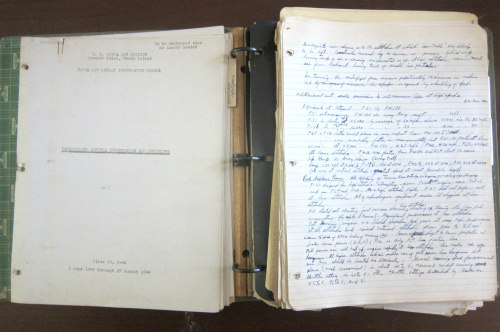
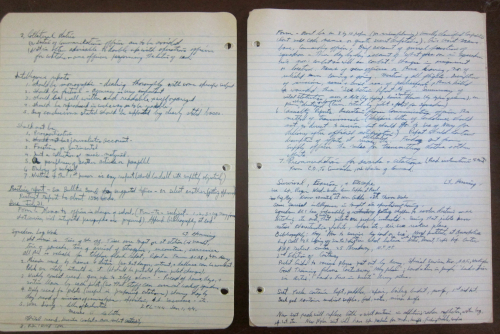
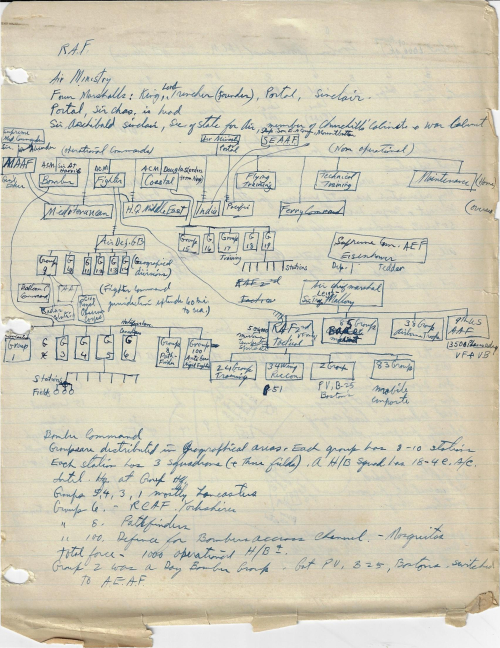
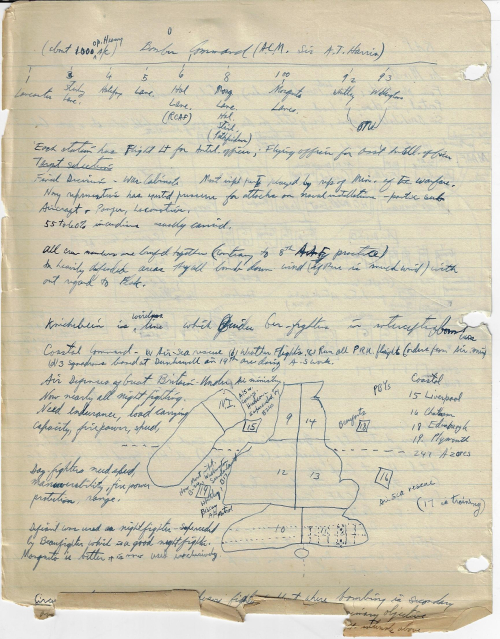
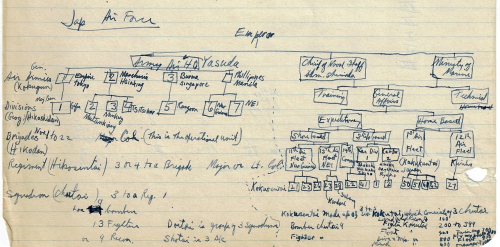
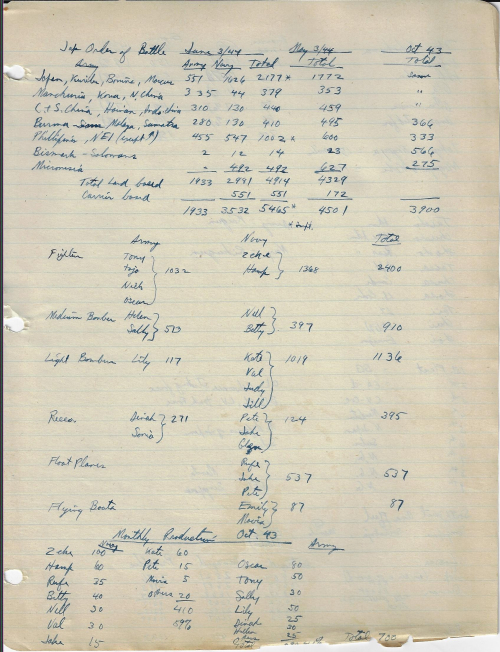
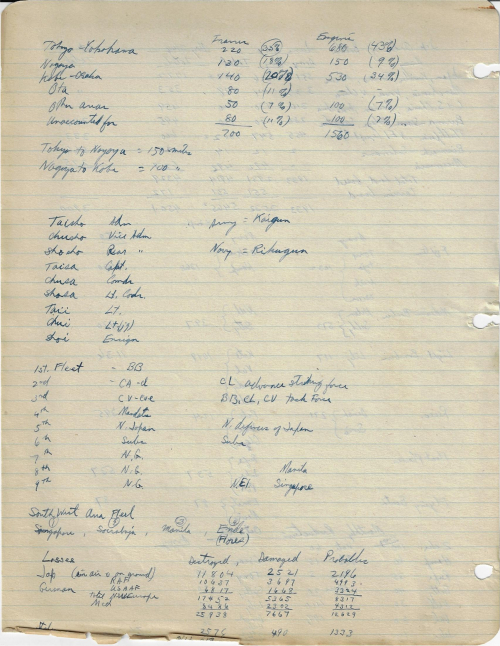
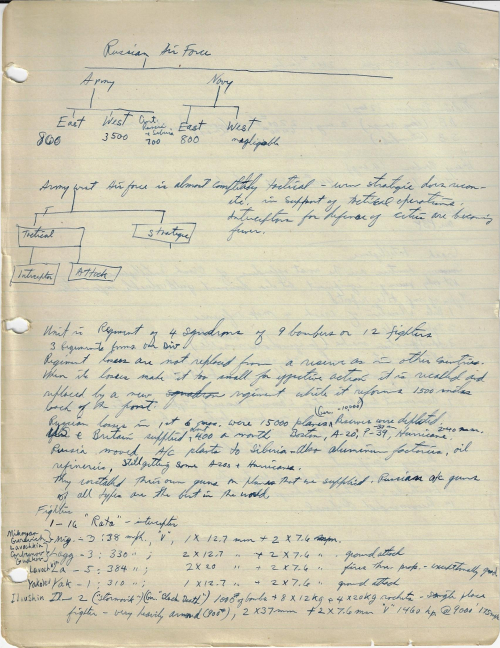
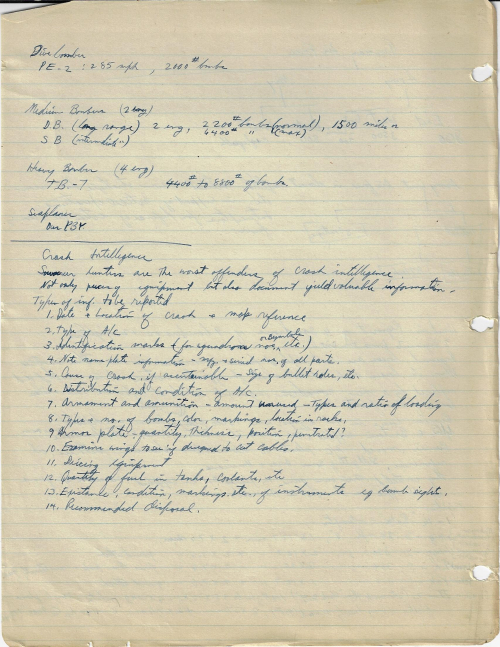
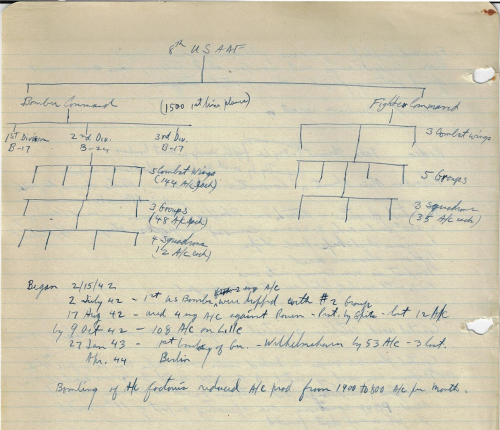
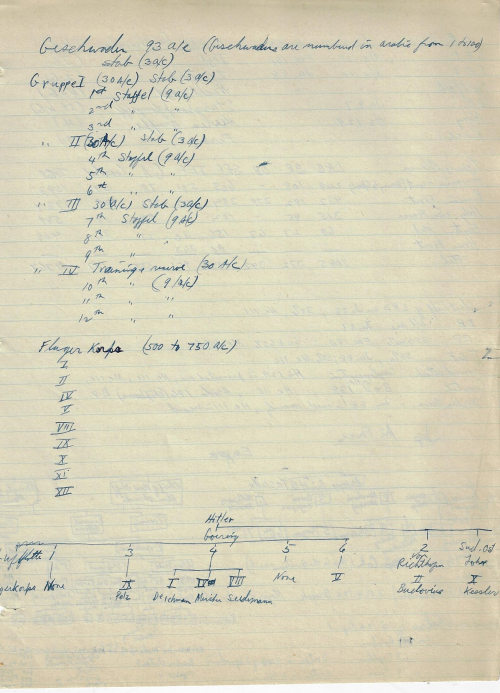
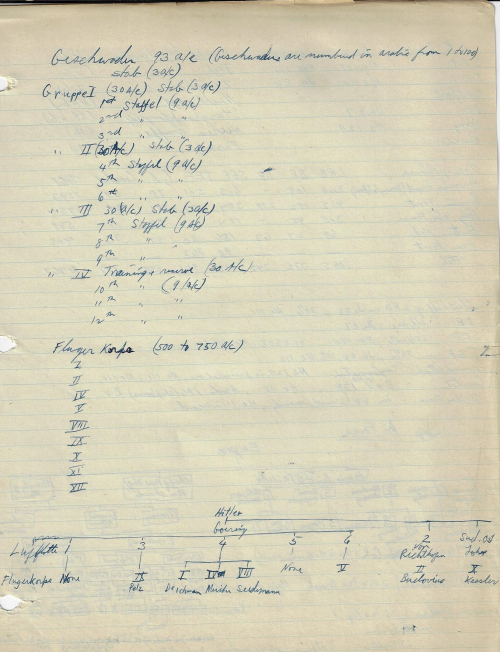
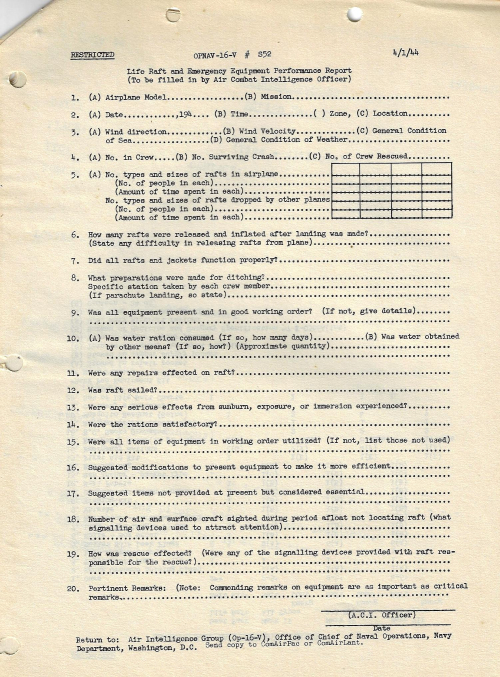
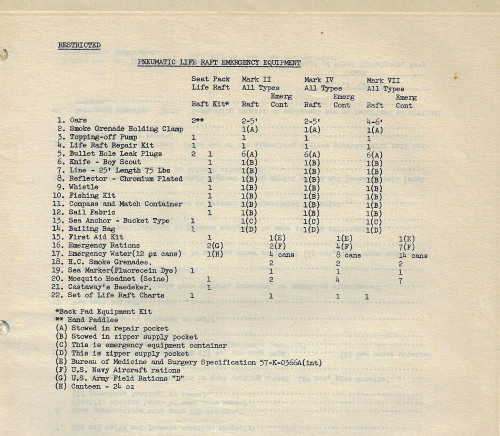


Comments